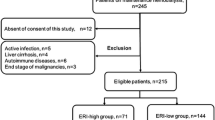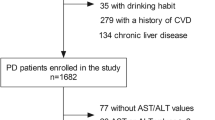Abstract
Background
We investigated whether butyrylcholinesterase (BChE) was independently related to the overall survival (OS) of patients on maintenance hemodialysis (MHD).
Methods
Baseline information, serum BChE level, and other laboratory data were collected from 295 patients on MHD in a single HD hospital in 2018. We retrospectively investigated the mortality of these patients after 38 months. We assessed the prognostic markers such as the Geriatric Nutritional Risk Index (GNRI), Erythropoiesis Resistance Index (ERI), and Simplified Creatinine Index (SCI) of each patient. The primary objective was to examine the impact of BChE on OS. The secondary objective included the designation of a risk score in predicting the OS.
Results
We evaluated 284 patients. The median value of the serum BChE level was 206 IU/L. Of 284 patients evaluated, eighty-six patients died; all had a higher ERI and a lower serum BChE level, SCI, and GNRI than the surviving patients. The optimal cutoff values of the BChE level, GNRI, ERI, and SCI for OS were 166 IU/L, 90.0, 8.00, and 20.6, respectively. The multivariate Cox regression analysis showed that the age, HD vintage, dialysis dose, GNRI of < 90.0, and serum BChE level of < 166 IU/L (hazard ratio, 2.03; P = 0.003) were the independent prognostic factors. We designed a risk score consisting of the GNRI and serum BChE level. The predictive value of our risk score was superior to that of GNRI alone.
Conclusion
The serum BChE level could be an independent prognostic factor for patients on MHD.





Similar content being viewed by others
Data availability statements
The datasets generated during and/or analyzed during this study are available from the corresponding author on reasonable request.
References
Go AS, Chertow GM, Fan D, McCulloch CE, Hsu C. Chronic kidney disease and the risks of death, cardiovascular events, and hospitalization. N Engl J Med. 2004;351:1296–305.
Lee HJ, Son YJ. Prevalence and associated factors of frailty and mortality in patients with end-stage renal disease undergoing hemodialysis: A systematic review and meta-analysis [Internet]. Vol. 18, International Journal of Environmental Research and Public Health. MDPI AG; 2021.
Sahathevan S, Khor BH, Ng HM, et al. Understanding development of malnutrition in hemodialysis patients: A narrative review [Internet]. Vol. 12, Nutrients. MDPI AG; 2020. p. 1–30.
Okamoto T, Hatakeyama S, Kodama H, et al. The relationship between poor nutritional status and progression of aortic calcification in patients on maintenance hemodialysis. BMC Nephrol. 2018;19:71.
Bae MN, Kim SH, Kim YO, et al. Association of erythropoietin-stimulating agent responsiveness with mortality in hemodialysis and peritoneal dialysis patients. PLoS ONE. 2015;10(11):e0143348.
Xiong J, Wang M, Zhang Y, et al. Association of geriatric nutritional risk index with mortality in hemodialysis patients: a meta-analysis of cohort studies. Kidney Blood Press Res. 2018;43:1878–89.
Canaud B, Ye X, Usvyat L, et al. Clinical and predictive value of simplified creatinine index used as muscle mass surrogate in end-stage kidney disease haemodialysis patients—results from the international monitoring dialysis outcome initiative. Nephrol Dial Transplant. 2021;35:2161–71.
Ogunkeye OO, Roluga AI. Serum cholinesterase activity helps to distinguish between liver disease and non-liver disease aberration in liver function tests. Pathophysiology. 2006;13:91–3.
Zivkovic AR, Schmidt K, Sigl A, et al. Reduced serum butyrylcholinesterase activity indicates severe systemic inflammation in critically ill patients. Mediators Inflamm. 2015;2015:1–11.
Okamoto T, Tsutaya C, Hatakeyama S, et al. Low serum butyrylcholinesterase is independently related to low fetuin-A in patients on hemodialysis: a cross-sectional study. Int Urol Nephrol. 2018;50:1713–20.
Koie T, Ohyama C, Yamamoto H, et al. Significance of preoperative butyrylcholinesterase as an independent predictor of survival in patients with muscle-invasive bladder cancer treated with radical cystectomy. Urol Oncol Semin Orig Investig. 2014;32:820–5.
Calderon-Margalit R, Adler B, Abramson JH, Gofin J, Kark JD. Butyrylcholinesterase activity, cardiovascular risk factors, and mortality in middle-aged and elderly men and women in Jerusalem. Clin Chem. 2006;52:845–52.
Santarpia L, Grandone I, Contaldo F, Pasanisi F. Butyrylcholinesterase as a prognostic marker: A review of the literature. J Cachexia, Sarcopenia Muscle. 2013;4(1):31–9.
Okamoto T, Hatakeyama S, Tanaka Y, et al. Butyrylcholinesterase level as an independent factor of erythropoiesis-stimulating agent resistance in patients on maintenance hemodialysis: a single-center cross-sectional study. Clin Exp Nephrol. 2018;22:1174–81.
Stojanov MD, Jovičić DM, Djurić SP, et al. Butyrylcholinesterase activity and mortality risk in hemodialysis patients: Comparison to hsCRP and albumin. Clin Biochem. 2009;42:22–6.
Okamoto T, Hatakeyama S, Konishi S, et al. Comparison of zinc acetate hydrate and polaprezinc for zinc deficiency in patients on maintenance hemodialysis: A single‐center, open‐label, prospective randomized study. Ther Apher Dial. 2019;1744–9987.13461.
Okamoto T, Hatakeyama S, Togashi K, et al. Pre-dialysis serum creatinine as an independent predictor of responsiveness to zinc supplementation among patients on hemodialysis. Clin Exp Nephrol. 2020;24:955–62.
Watanabe Y, Kawanishi H, Suzuki K, et al. Japanese Society for Dialysis Therapy Clinical Guideline for “Maintenance Hemodialysis: Hemodialysis Prescriptions.” Ther Apher Dial. 2015;19:67–92.
Bouillanne O, Morineau G, Dupont C, et al. Geriatric Nutritional Risk Index: a new index for evaluating at-risk elderly medical patients. Am J Clin Nutr. 2005;82:777–83.
Terrier N, Jaussent I, Dupuy AM, et al. Creatinine index and transthyretin as additive predictors of mortality in haemodialysis patients. Nephrol Dial Transplant. 2008;23:345–53.
Canaud B, Vallée AG, Molinari N, et al. Creatinine index as a surrogate of lean body mass derived from urea Kt/V, pre-dialysis serum levels and anthropometric characteristics of haemodialysis. PLoS One. 2014;9.
Youden WJ. Index for rating diagnostic tests. Cancer. 1950;3:32–5.
Hubbard RE, O’Mahony MS, Calver BL, Woodhouse KW. Plasma esterases and inflammation in ageing and frailty. Eur J Clin Pharmacol. 2008;64:895–900.
Garcia SC, Wyse ÂTS, Valentini J, et al. Butyrylcholinesterase activity is reduced in haemodialysis patients: Is there association with hyperhomocysteinemia and/or oxidative stress? Clin Biochem. 2008;41:474–9.
Schiffl H, Lang SM, Stratakis D, Fischer R. Effects of ultrapure dialysis fluid on nutritional status and inflammatory parameters. Nephrol Dial Transplant. 2001;16:1863–9.
Sukkar SG, Gallo F, Borrini C, et al. Effects of a new mixture of essential amino acids (Aminotrofic ®) in malnourished haemodialysis patients. Med J Nutrition Metab. 2012;5:259–66.
Acknowledgements
We thank Sakiko Fujita, Akiko Kimura, Mieko Kawamura, Chizu Kawase, Kumiko Sato, and Masahiko Tezuka for their invaluable help with data collection. We would like to appreciate all staff in Oyokyo Kidney Research Institute Aomori Hospital for their valuable follow-up and Enago (www.enago.jp) for the English support.
Funding
No funding was received to assist with the preparation of this manuscript.
Author information
Authors and Affiliations
Contributions
Conceptualization: TO; data curation: all authors; formal analysis: TO and KF; funding acquisition: not applicable; investigation: all authors; methodology: TO and KF; project administration: TO and SH; resources, software, supervision: CO validation: not applicable; visualization: not applicable; roles/writing—original draft: TO and KF; writing—review and editing: TO and KF; final approval of manuscript: all authors.
Corresponding author
Ethics declarations
Conflict of interests
All authors have no conflicts of interest to declare.
Ethical approval
This study was approved by the ethics committee of Hirosaki University Graduate School of Medicine (IRB number, Ken11H30001). The trial is registered in the UMIN Clinical Trials Registry UMIN000031200. All patients provided verbal informed consent to use data for this secondary post hoc analysis, which was recorded in their medical charts. The ethics committee of Hirosaki University School of Medicine permitted this procedure. All procedures that were performed in studies involving human participants were according to the ethical standards of the institutional and/or national research committee and with the 1964 Helsinki Declaration and its later amendments or comparable ethical standards.
Informed consent
Informed consent was obtained from all individual participants included in the study.
Additional information
Publisher's Note
Springer Nature remains neutral with regard to jurisdictional claims in published maps and institutional affiliations.
Supplementary Information
Below is the link to the electronic supplementary material.
About this article
Cite this article
Fukushi, K., Okamoto, T., Ozaki, Y. et al. Butyrylcholinesterase level as an independent prognostic factor for overall survival in patients on maintenance hemodialysis: a single-center retrospective study. Clin Exp Nephrol 26, 190–197 (2022). https://doi.org/10.1007/s10157-021-02140-6
Received:
Accepted:
Published:
Issue Date:
DOI: https://doi.org/10.1007/s10157-021-02140-6




